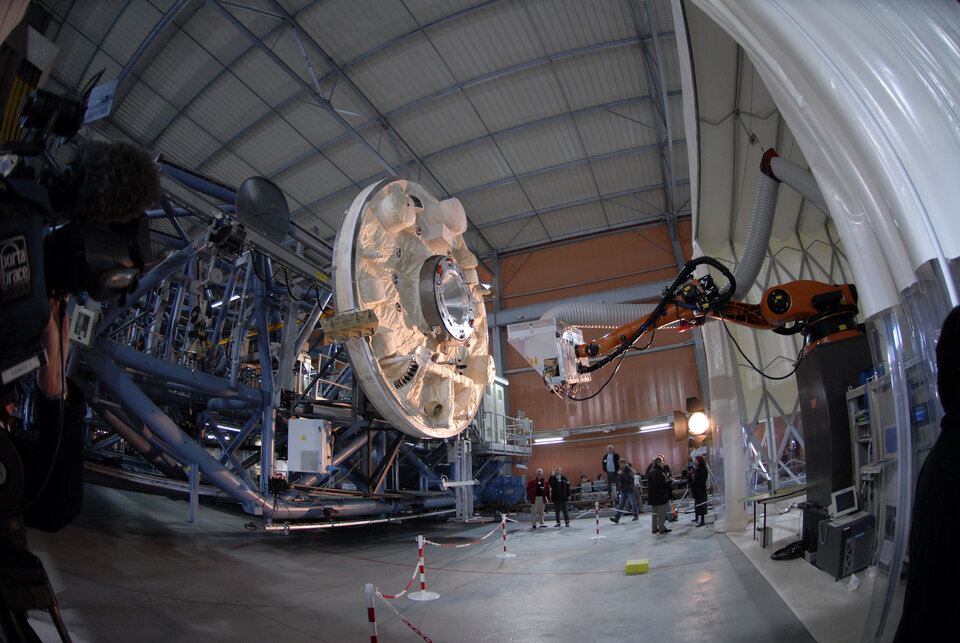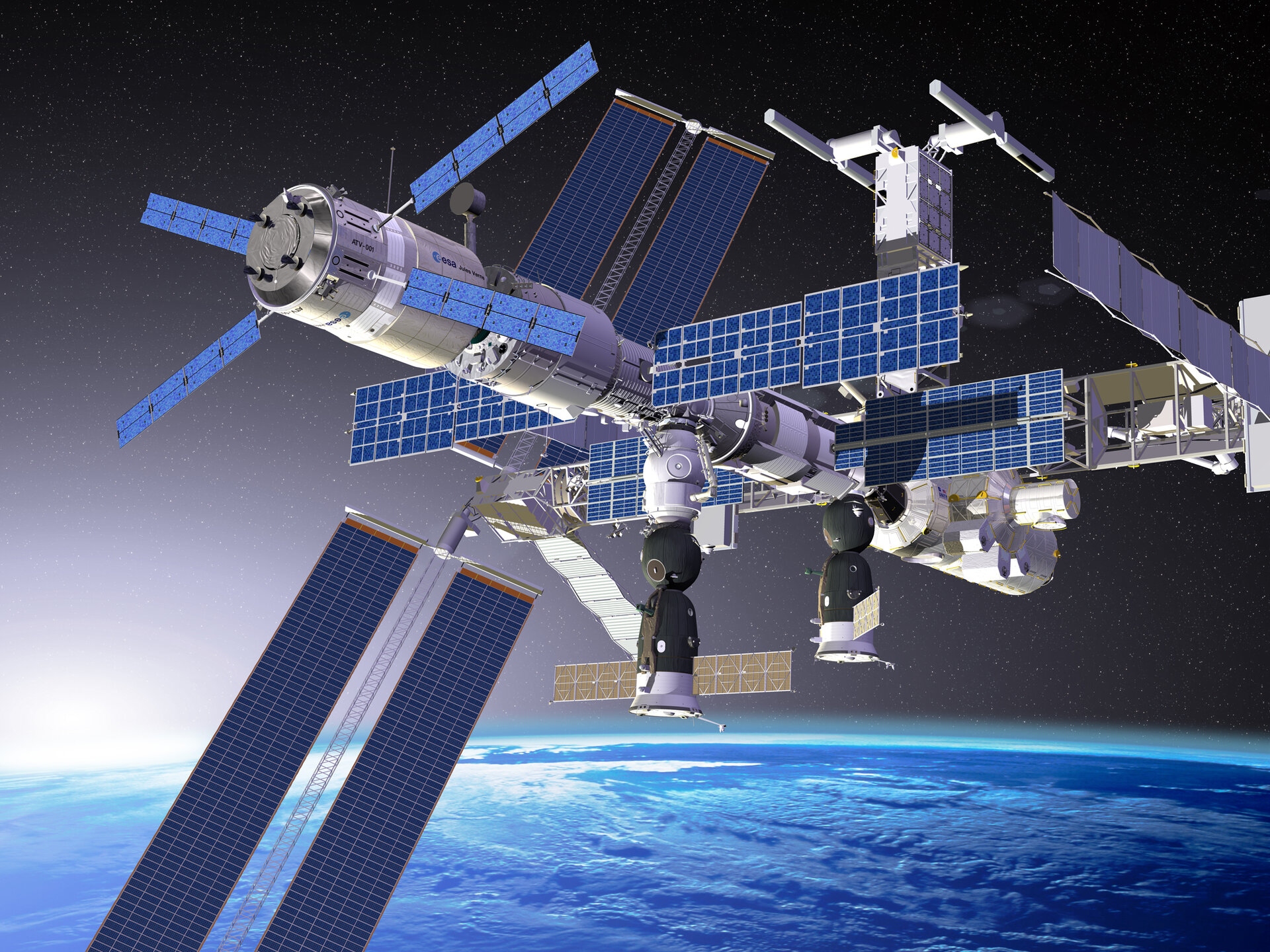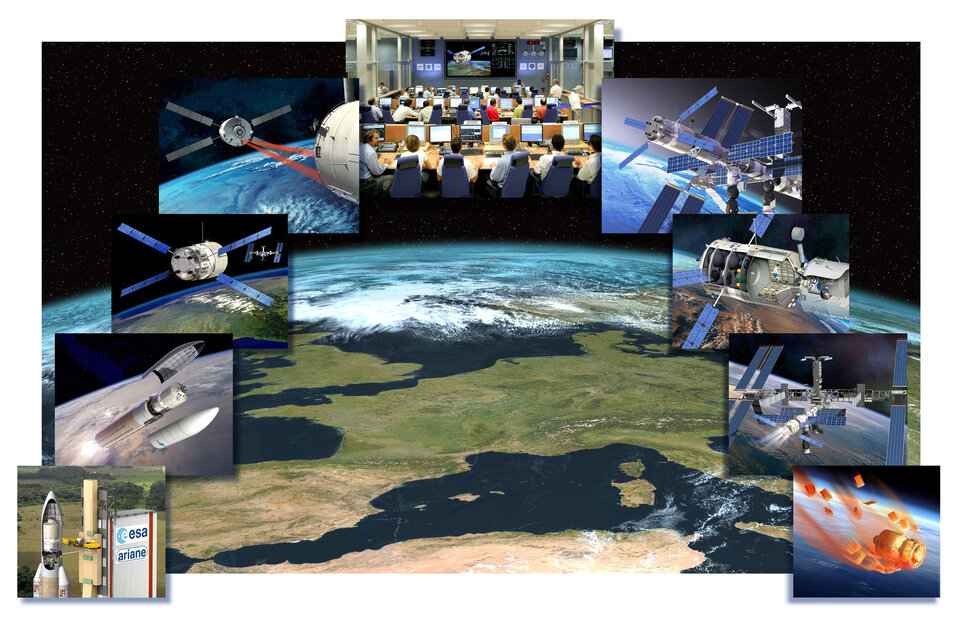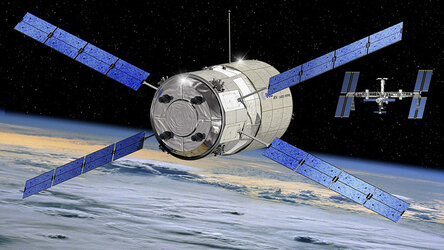Worldwide testing and ISS traffic push ATV launch to autumn 2007
Jules Verne, the first of five Automated Transfer Vehicles (ATV), stands on the brink of flight. Its hardware is 100 percent assembled and ready to fly. The inaugural mission, set for the second half of 2007, will follow an extensive three-year test campaign.
Prime contractor and ESA teams are working overtime to finish the testing of the most complex spaceship ever developed in Europe. During the coming crucial months, this state-of-the-art programme faces three key concurrent objectives: to fully prepare for Flight Operations, to fine-tune the interfaces with the International Space Station and the Station partners, and to prepare Ariane 5 for launching its largest payload to date.
For the past months, the main challenge of ATV qualification testing has been to run parallel test campaigns involving a variety of interfaces with different partners. The primary objective of this complex and time-consuming strategy is to ensure that ATV's hardware and software can handle all possible nominal and off-nominal scenarios that Jules Verne might face during its flight.

For instance, at the RSC-Energia plant outside Moscow - the manufacturing site for the ATV docking mechanism, the refuelling system and the associated electronics - major computer simulations have been underway from December through to March at the GDC (Ground Debugging Complex). There, a powerful simulator purposely introduces several failure scenarios and creates artificially degraded situations that the ATV architecture must cope with, while respecting the tough requirements of human spaceflight.
The objective is to test the final version of the software used, firstly to interface between the ATV and the Russian module when they initiate rendezvous and docking, as well as the software used later after docking to allow the Russian module to take control the ATV propulsion system for re-boost and attitude control of the 220-tonne ISS. Tests have included actual communications hardware and GPS simulators.
This test campaign, which is now reaching a successful conclusion, has suffered significant delays due to unexpected problems during the validation of the Russian segment GPS, which is needed by the ATV's relative navigation system. Corrective actions, including a software upgrade, have now finally resulted in a successful test.

At the same Russian plant, another two-month campaign, set for this spring, will test real interfaces with the massive replica of the 12.6 m long Russian Module at the Control and Testing Station (KIS) facility. Thanks to actual physical interfaces, it is possible to test the Russian docking and refuelling system with real fluids and pressurized tanks. Jules Verne, like the Russian Progress vehicle, has the capability to refuel the Station with 860 kg of propellant and evacuate 840 kg of liquid waste.
Meanwhile, at ESA's European Space Research and Technology Centre (ESTEC), in Noordwijk, the Netherlands, the Jules Verne spaceship underwent two major environment tests during 2006. The first one was the acoustic test, to verify the capability of the spacecraft to withstand the noise loads experienced during launch. This test was successfully completed in July.
Next came a thermal vacuum test to verify that Jules Verne, in active status, is able to sustain the harsh space conditions with extreme temperatures in a vacuum. Despite the readiness of the spacecraft itself, this test had to be postponed due to the underestimated time needed to define precisely the test procedures – which must be perfect – when the flight hardware is involved. Eventually one week before Christmas last year, Jules Verne went through this test successfully.
Also in autumn 2006, thanks to Europe’s largest ship hull test facility, west of Paris, the Jules Verne rendezvous technique was tested successfully. For the first time the system worked in complete 'closed-loop' conditions where all aspects of the spacecraft were either represented for real – computers, software, sensors, trajectories – or simulated such as Jules Verne's inertia, thruster firing etc..
Getting ready

Several mission scenarios will require complex interactions and shared responsibilities between the ATV Control Centre (ATV-CC) in Toulouse, France, and Russian and American Mission Control Centres in Moscow and Houston. For the first time in space history, three space control centres around the globe must work together. For these Joint Activities related to the ATV in orbit, specific high-level procedures, called Multi-Element Procedures, have been developed, allocating the tasks to be performed sequentially to the centres involved. A dozen simulations involving the three centres remain ongoing to fine-tune the procedures for nominal and off-nominal scenarios that Jules Verne could face.

At the same time, the ISS Expedition 16 crew, Yuri Malenchenko and Peggy Whitson, has started the ATV training at the European Astronaut Centre in Cologne, Germany. "Their task during rendezvous will be similar to that of an aircraft crew monitoring an auto-land involving 14 different parameters, with no back-up manual control except the possibility to command an automatic go-around maneuver", said ESA astronaut Jean-François Clervoy, the senior advisor to the ATV programme.
Now that all the numerous tests and campaign challenges are nearing completion, Jules Verne should be ready for shipment to the launch site in summer 2007. The transportation of ATV and its 400 tonnes of ground support equipment from ESA's test centre in the Netherlands to Kourou, French Guiana, will take two weeks by sea on board the Ariane 5 transportation ship, Toucan.
"It is very encouraging to see that most of the problems we have encountered in the last years are now solved and although we still have plenty of work to do, we can foresee that we will be ready to ship Jules Verne to French Guiana in the next few months ready for the launch”, said John Ellwood ESA’s ATV Project Manager.
Since the ATV is the heaviest and most complex spacecraft project ever developed in Europe, and because of its demanding requirements of human spacecraft safety, the launch campaign at the Centre Spatial Guyanais (CSG) in French Guiana will extend almost four months before lift-off.
Final launch date

Meanwhile in Europe, from April to mid-summer, an extensive review will be conducted with NASA and the Russians to be sure that Jules Verne, its facilities and tri-lateral ATV procedures are ready to support Jules Verne ATV inaugural mission.
Qualification of the ATV Control Centre is almost finalized, a large part of the system validation test programme has been completed and the normal operations qualification programme has started and is on schedule for launch readiness by end-July this year.
Besides the readiness of Jules Verne and its control centre, numerous external constraints considerably limit the Jules Verne docking date opportunities which in turn reduce the launch date opportunities.
One major natural constraint is given by the Sun angle with respect to the ATV-ISS line of sight during the final approach: this angle must be low enough to maintain proper power supply to ISS and high enough to avoid dazzling the rendezvous sensors. This constraint opens two launch windows, one in September and another in November.
Other major constraints are driven by the traffic of other space vehicles to and from the Space Station and the availability of the docking port usually taken by a Russian re-supply ship Progress.

Another unfortunate weather event recently reshuffled the already intricate Jules Verne launch date equation. The recent hail damage incurred by the Space Shuttle's External Tank on the launch pad in Florida is currently being assessed and NASA has already announced that it will impact the Shuttle flight manifest of this autumn by a few weeks.
Taking into account on the one hand the delays encountered recently by the test teams in Russia and in Europe, due to unexpected but now resolved problems, and on the other hand the addition of external constraints on the possible launch dates, it is now understood that the first possible Jules Verne launch opportunities are not earlier than September with a possibility of schedule slip to November depending on the resolution of the Shuttle manifest re-planning and the priority given to ATV to re-supply the Station with up to 6 tonnes of cargo.
ESA management is in discussion with its International Partners to ensure that Jules Verne will be able to fly at the earliest feasible and safe opportunity, thereby demonstrating that Europe has the ability to provide the logistics capability. It is also a way for Europe to pay its share in ISS running costs by spending money within the European industry rather than by cash transfers to its International Partners.








